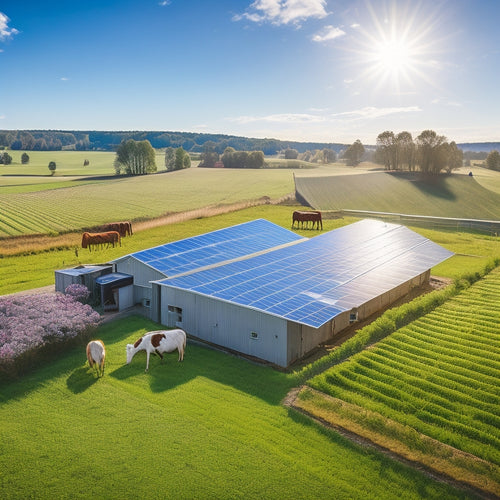
Mounting Solar Panels on Shingle Roofs
Share
When mounting solar panels on your shingle roof, you'll want to start with a thorough roof inspection to identify any potential issues, ensuring your roof is structurally sound and free from leaks. From there, you'll need to choose a mounting system that suits your roof type and solar panel setup, with options ranging from rail-based systems to adhesive-based mounts. Each has its own set of considerations, such as weight capacity, durability, and waterproofing. By selecting the right system and following best practices for installation, you'll be well on your way to a secure and efficient solar panel setup - and there's more to investigate to get it just right.
Overview
- Ensure roof condition and structural integrity can support solar panel weight and withstand environmental factors.
- Choose a suitable mounting system (rail-based, clamp-based, adhesive-based, or standalone) considering shingle type, roof pitch, and panel size.
- Select durable flashing materials (aluminum or stainless steel) and compatible sealants (silicone or polyurethane) for a watertight installation.
- Consider waterproofing, streamlined design, easy installation, and compatibility when selecting a solar panel mounting system.
- Properly install flashing and sealants to prevent water intrusion and ensure a long-lasting, leak-free solar panel installation.
Roof Preparation and Inspection
Before mounting solar panels on your shingle roof, confirming the roof is ready for the installation is essential.
You'll want to assess the roof's condition, checking for signs of wear, damage, or aging. Conduct a moisture assessment to identify any water intrusion or leaks.
Evaluate the insulation to guarantee it's adequate and functioning properly. Verify the structural integrity of the roof to ascertain it can support the weight of the solar panels.
Check the shingle lifespan to determine if replacement is necessary. Performing regular maintenance strategies, including inspections and performance monitoring, can help identify potential issues early on.
Off-grid solar systems require careful planning and installation to achieve peak energy generation and storage.
Perform a ventilation check to verify proper airflow and reduce the risk of moisture buildup. Inspect for damage, including curled, buckled, or missing shingles.
Rail-Based Mounting Systems
With your shingle roof prepared and inspected, it's time to choose a mounting system that securely fastens your solar panels in place.
Rail-based mounting systems are a popular choice, offering exceptional solar panel durability. These systems feature rails that run along the roof, providing a solid foundation for your panels.
You'll want to make certain that the rails are spaced correctly to accommodate the weight and size of your panels. Considering high-efficiency solar charging solutions, it's vital to maximize energy harvesting strategies for low-light conditions.
Following installation best practices, you'll attach the panels to the rails using clamps or bolts. Properly installed, rail-based systems provide a secure and stable platform for your solar panels, guaranteeing peak energy production and minimizing the risk of damage or dislodgement.
Clamp-Based Mounting Systems
As you investigate alternative mounting options, clamp-based systems emerge as a viable solution, offering a secure and efficient way to fasten your solar panels to the roof.
Clamp-based systems employ various clamp types, including S-clamps, C-clamps, and snap-in clamps, each designed for specific shingle types and roof profiles.
When selecting a clamp-based system, consider factors like roof pitch, shingle material, and panel size. It's vital to confirm the weight capacity of the mounting rack exceeds the total equipment weight for a safety margin Secure Connections and to choose a rack material that impacts durability, such as aluminum or stainless steel.
Proper installation techniques are key to guarantee a secure and watertight seal. Make sure to follow manufacturer guidelines and local building codes to assure a safe and efficient installation.
Adhesive-Based Mounting Options
Adhesive-based mounting options provide an alternative to clamp-based systems, offering a sleeker, more streamlined appearance and reduced visibility of the mounting hardware.
When choosing an adhesive-based system, you'll need to select an appropriate adhesive type, such as acrylic, polyurethane, or butyl-based. Each type has its own strengths and weaknesses, so it's vital to take into account factors like durability, UV resistance, and compatibility with your shingle type.
During installation, you'll apply the adhesive to the roof attachment points, ensuring a secure bond between the solar panel and your roof. Proper installation techniques, such as cleaning the surface and applying even pressure, are fundamental for a reliable and long-lasting bond.
Standalone Solar Panel Mounts
When choosing standalone solar panel mounts, you'll want to guarantee they provide secure roof anchor points that can withstand various environmental conditions.
These mounts should also allow for adjustable panel tilt to optimize energy production based on your location and season.
Additionally, look for a waterproof flashing system that prevents water intrusion and guarantees a leak-free installation.
Secure Roof Anchor Points
You'll need to identify secure roof anchor points to confirm your standalone solar panel mounts are safely and reliably fastened to your shingle roof. This guarantees the structural integrity of your roof remains intact while supporting the weight of your solar panels.
| Anchor Point Type | Description |
|---|---|
| Roof Truss Anchor | Attaches directly to the roof truss, providing a solid anchor point |
| Rafters Anchor | Secures to the rafters, offering a reliable connection |
| Flashing Anchor | Seals around the anchor point, protecting against water intrusion |
| Deck Anchor | Attaches to the roof deck, providing a sturdy base |
| Bracket Anchor | Customizable brackets for unique roof shapes and sizes |
Adjustable Panel Tilt
The tilt of your standalone solar panel mounts greatly impacts energy production, with a perfectly angled array maximizing energy harvest.
You want to ascertain your solar panels are at the ideal tilt to achieve maximum solar panel efficiency. Adjustable panel tilt systems allow you to fine-tune the angle of your panels to match the changing seasons, capturing more energy throughout the year.
Waterproof Flashing System
By integrating a waterproof flashing system into your standalone solar panel mounts, you're guaranteeing a watertight seal that protects your shingle roof from water intrusion. This critical component involves selecting the right flashing materials and mastering installation techniques to prevent water seepage.
| Flashing Materials | Installation Techniques |
|---|---|
| EPDM (Ethylene Propylene Diene Monomer) | Peel-and-stick application |
| Butyl-based flashing | Mechanical fastening |
| Aluminum or stainless steel | Clamping and sealing |
| Silicon-based sealants | Taping and mudding |
When choosing flashing materials, consider factors like durability, flexibility, and UV resistance. For installation techniques, guarantee a secure and watertight seal by following manufacturer guidelines and best practices.
Integrated Racking Systems
When you're designing an integrated racking system for your shingle roof, you'll want to evaluate a racking system design that allows for ideal energy production while ensuring a secure and watertight installation.
A well-planned design will enable seamless roof integration, minimizing the risk of leaks and ensuring a trouble-free installation.
Racking System Design
How do you guarantee a secure and efficient mounting of solar panels on a shingle roof?
You start by designing a sturdy racking system that distributes the load of the panels evenly across the roof. This means selecting high-quality racking materials that can support the weight of the panels and withstand harsh weather conditions.
A well-designed racking system guarantees that the panels are securely fastened to the roof, minimizing the risk of damage or displacement. By optimizing load distribution, you can reduce the weight on individual shingles, preserving the integrity of your roof.
A thoughtfully planned racking system design is essential to a successful solar panel installation that provides you with freedom from high energy bills.
Seamless Roof Integration
You've selected a sturdy racking system, now it's time to contemplate how to seamlessly integrate it with your shingle roof. Integrated racking systems guarantee a watertight seal and optimize energy efficiency. These systems eliminate the need for clamps and brackets, providing a sleek, streamlined appearance that enhances solar aesthetics.
| Feature | Benefit |
|---|---|
| Waterproofing | Protects your roof from water damage |
| Streamlined design | Enhances solar aesthetics and energy efficiency |
| Easy installation | Reduces labor costs and installation time |
| Compatibility | Suitable for various shingle types and roof angles |
| Durability | Withstands harsh weather conditions and lasts long |
Flashing and Sealant Applications
Flashing and sealant applications are critical components of a watertight solar panel installation on a shingle roof, as they work in tandem to protect the roofing material and guarantee a long-lasting, leak-free installation.
When selecting flashing materials, you'll want to choose durable, weather-resistant options that can withstand harsh environmental conditions. Aluminum or stainless steel flashing materials are popular choices, as they're resistant to corrosion and can be easily molded to fit around obstructions.
Sealant types, such as silicone or polyurethane-based sealants, should be chosen based on their compatibility with the flashing material and roofing substrate.
Proper application of flashing and sealants guarantees a watertight seal, giving you peace of mind and protecting your investment.
Frequently Asked Questions
Can Solar Panels Be Installed on Roofs With Multiple Layers of Shingles?
When you're dealing with a roof having multiple shingle layers, you'll face installation challenges; however, it's still possible to install solar panels, but you'll need to take extra precautions to guarantee a secure and watertight fit.
How Do I Handle Obstructions Like Vents or Skylights on My Roof?
Imagine your roof as a canvas, awaiting a masterpiece of solar panels. When maneuvering around obstacles, you'll carefully plan vent placement and skylight integration, ensuring a seamless installation that harmonizes with your roof's unique features, releasing freedom from energy bills.
Are Solar Panels Compatible With Metal or Clay Tile Roofs?
You'll find solar panels can work with metal or clay tile roofs, but consider the solar panel materials' weight and compatibility with your roof's structural integrity, ensuring a secure and efficient installation that frees you from energy constraints.
Do Solar Panels Void My Roof's Warranty or Insurance?
When you install solar panels, you're concerned about warranty implications and insurance coverage. Typically, your roof's warranty remains intact, but you'll need to check with your provider; insurance coverage usually isn't affected, but it's crucial to notify your insurer to guarantee continued protection.
Can I Install Solar Panels Myself or Do I Need a Professional?
You're a brave pioneer, charting your own course towards energy independence. But, before you commence a DIY installation, steer through the complex terrain of solar panel regulations, ensuring you don't get lost in a sea of permits and codes.
Ready to Buy
You've successfully maneuvered the complex process of mounting solar panels on shingle roofs. The key takeaway: a thorough roof preparation and inspection is essential to ensuring a secure and watertight installation, regardless of the mounting system you choose. In fact, studies have shown that a well-executed installation can increase the lifespan of both the roof and the solar panels by up to 20%. By following the guidelines outlined in this article, you'll be able to utilize the power of the sun with confidence.
Related Posts
-

What Do I Need to Know About Farm Solar Panels
When considering farm solar panels, you need to assess costs, benefits, and technical specifics. Initial investment c...
-

Smart Home Thermostats to Revolutionize Your Space
Smart home thermostats revolutionize your space by providing precise temperature control and optimizing energy saving...
-

High-Efficiency Solar Battery Chargers for Remote Areas
High-efficiency solar battery chargers are essential for your off-grid energy needs in remote areas. They maximize en...


